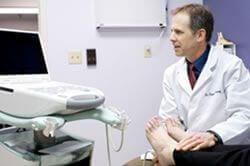Below are frequently asked questions about cortisone injections.
The purpose of cortisone injections:

The goal is to decrease the inflammation directly at the site of the problem. When an oral anti-inflammatory medication is taken, it has to go throughout the whole body. Often, the dosage in your foot is the same as your legs and in your hands with an oral medication. But if you have a painful heel, you are not getting the ideal therapeutic dosage. So, when a cortisone injection is done we are able to put a therapeutically effective dosage of the medication right where it is needed.
Ultrasound guidance:
Often times we are able to use ultrasound guidance to make certain that the cortisone is placed in the exact location necessary.  This has several benefits; we can use a lower dosage by having it exactly where it is needed. Also we can avoid injecting into areas where it's not as effective or specificallycould cause potential problems. For example, an injection for plantar fasciitis in the heel is most effective at the layer between the plantar fascia and the fat pad. If we inject into the fascia directly there is a higher risk of the fascia will weaken and even have a partial tear. If the injection was done into the plantar fat pad and this could thin the fat pad out (especially with repeated injections). But if it is injected between the 2 layers, then the potential for these problems is minimized.
This has several benefits; we can use a lower dosage by having it exactly where it is needed. Also we can avoid injecting into areas where it's not as effective or specificallycould cause potential problems. For example, an injection for plantar fasciitis in the heel is most effective at the layer between the plantar fascia and the fat pad. If we inject into the fascia directly there is a higher risk of the fascia will weaken and even have a partial tear. If the injection was done into the plantar fat pad and this could thin the fat pad out (especially with repeated injections). But if it is injected between the 2 layers, then the potential for these problems is minimized.
How quickly will be injection-medication work?
Sometimes it takes 2 or 3 days before the injection really is effective. This is partly because the longer acting component of the cortisone is in a crystalline form and requires time after the injection to become usable by the body (the crystals need to "dissolve"). During this time frame it can actually hurt worse than before the injection. But once the cortisone has passed this initial threshold time frame, there is usually dramatic reduction in pain and inflammation.
How long will the cortisone injection work?
It should last for least 3 weeks but sometimes can last 2 or 3 months, or longer. Many problems with the foot are mechanical in nature. Therefore, there is often both an inflammatory component of the problem and a mechanical component to the problem. So, if we are able to address the mechanical dysfunction, for example with prescription orthotics, then the cortisone injection can effectively address the inflammatory component. Oftentimes there is more of a long-term resolution with this approach.
Can I go exercise right away?
It is recommended that you take it easy for least 2 or 3 days after a cortisone injection. It is recommended that you discuss (with your Doctor) any special plans for high-impact exercise such as running.
Are there any risks with an injection?
There is a very small risk of infection related to the injection. Therefore the injection site is prepped with alcohol to help minimize this risk. There is also the risk that some the underlying structures are weak prior to the injection and will become further weakened with cortisone. As mentioned, a cortisone injection directly into the plantar fascia is commonly done. But this increases the risk of partial tearing of the fascia. Therefore at our clinic, we like to inject at the interface between the fascia and the fat pad to help minimize this risk.
More information about Cortisone Injections at The Issaquah Foot and Ankle Specialists.
Some patients might be leery of an injection in their foot, but our office has a solution to this fear. We used what is called a Transcutaneous Electrical Nerve Stimulation (TENS) unit. The TENS unit works by sending stimulating pulses across the surface of the foot and along the nerve strands. The stimulating pulses help prevent pain signals from reaching the brain so a patient doesn't even feel the injection as it's happening.



